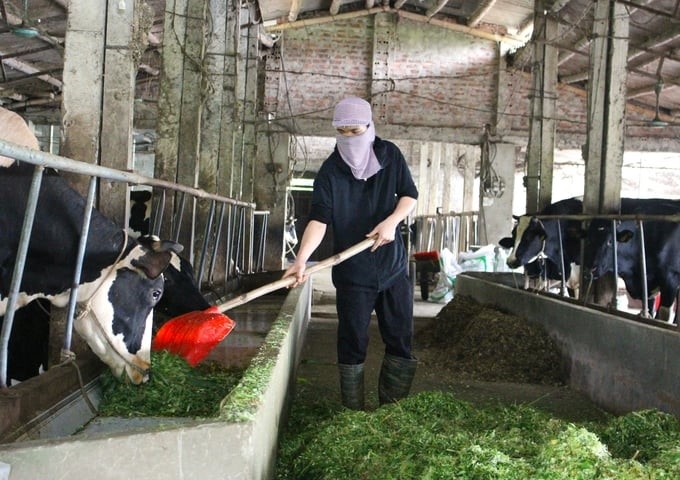November 28, 2025 | 08:43 GMT +7
November 28, 2025 | 08:43 GMT +7
Hotline: 0913.378.918
November 28, 2025 | 08:43 GMT +7
Hotline: 0913.378.918
According to the Ha Nam Sub-Department of Animal Husbandry and Veterinary Medicine, by the end of June 2024, the pig herd in the whole province is estimated to reach 385,000 heads, poultry of approximately 9 million heads, and buffalos and cows of more than 37,000 heads. The strong development of breed technology, along with farmers' access to and training in technical solutions through agricultural extension programs and projects, has helped the province's livestock industry make clear changes, increasing productivity and efficiency.

Ha Nam's livestock industry has made clear changes; however, developing biosafety farming still faces many difficulties. Photo: Trung Quan.
However, the transformation to farm-scale livestock farming is still slow, and the livestock linkage chain is loose and unsustainable.
Environmental pollution caused by livestock farming activities in some localities has not been thoroughly and effectively treated. Most livestock households build barns according to experience, so their barns are not technically guaranteed, causing difficulties in cleaning, disinfection, and sterilization.
Regarding breeds, there is still a small part of small-scale livestock households buying breeds that are not quarantined when first imported through traders. This is one of the great risks that lead to spreading and breaking out diseases, especially African swine fever disease.
Regarding feed, most livestock households use complete mixed feed for livestock. However, feed preservation is not guaranteed. Most do not arrange separate feed warehouses or have feed warehouses but do not have shelves; confuse feed with cleaning tools and veterinary medicine; and have no measures to prevent rats and insects from entering. Some households mix their own feed but cannot control the origin and quality of input grains such as corn, rice bran, soybeans, etc.
Faced with that reality, to develop livestock farming sustainably, the province's agricultural sector has promoted the construction of pilot models for biosafety farming on many different livestock objects so that professional staff as well as breeders can learn and apply.

Ha Nam's agricultural sector encourages the development of professional, farm-scale livestock farming. Photo: Trung Quan.
Besides, Ha Nam's agricultural sector also encourages the development of professional, farm-scale livestock farming. Accelerate the application of high and advanced technology in livestock farming, such as closed barn technology, biotechnology, automation in care, raising, disease management, etc. Widely apply artificial insemination technology in raising dairy cows, breeding cows, and pigs; continue to transfer techniques to increase the rate of artificial insemination in pig and poultry farming. At the same time, build disease-safe facilities and linkage chains of production, pre-processing, processing, and consumption of livestock products.
In addition, focus on bringing technology into livestock farming, strengthening consumption-market connections, creating stable output to stimulate production, diversifying the structure of livestock breeds, and creating favorable conditions for the application of biosafety measures in production.
Translated by Thu Huyen

(VAN) Circular agriculture helps Mekong Delta farmers cut greenhouse gas emissions while boosting incomes through efficient reuse of agricultural by-products.

(VAN) According to Mr. Vo Minh Thanh, Director of the Tay Ninh Department of Agriculture and Environment, Resolution 57 has created a new development pathway for the locality, shifting from traditional toward modern agriculture.
/2025/11/26/4909-2-154329_878.jpg)
(VAN) Pearl grouper farming in HDPE cages not only delivers economic efficiency but also contributes to protecting the environment, creating jobs, and promoting marine-based experiential tourism.

(VAN) The model of making a living under the forest canopy through the agroforestry system in Van Son commune, Bac Ninh province, is expected to generate an annual income of approximately VND 30 million/ha.

(VAN) Many enterprises in Can Tho are harnessing natural energy and reducing greenhouse gas emissions in their production processes, thereby contributing to the promotion of a sustainable green transition.
/2025/11/24/3536-2-112800_176.jpg)
(VAN) Dong Nai now has tens of thousands of hectares of forests certified for sustainable management, and this area will continue to be expanded in the coming period.

(VAN) Vinh Ha hamlet (Dai Xuyen commune, Hanoi) is shifting away from small-scale farming as households adopt bioscurity into their breeder chicken models.